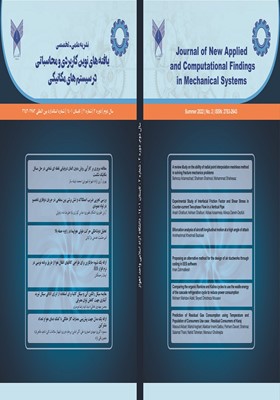ارائه یک شیوه جایگزین برای طراحی کانالهای انتقال هوا از طریق برنامه نویسی در نرم افزار EES
محورهای موضوعی : یافته های نوین کاربردی و محاسباتی در سیستم های مکانیکی
1 - گروه مکانیک، واحد مشهد، دانشگاه آزاد اسلامی، مشهد، ایران
کلید واژه: روش سطح پاسخ, فن, تعیین اندازه, نرم افزار EES, کانال هوا,
چکیده مقاله :
در طراحی کانالهای هوا ابتدا یک سرعت مجاز برای هوا در شاخه اصلی در نظر می گیرند. سپس، بر اساس این سرعت و دبی در شاخه اصلی، قطر کانال و اتلاف هد در آن تعیین می شود. البته، برای کانالهای مستطیلی، ابعاد را با توجه محدودیت ارتفاع کانال مشخص می کنند. سپس، قطر کانال (یا ابعاد کانال مستطیلی) در شاخه های دیگر بر پایه دبی در هر شاخه و مقدار اتلاف هد شاخه اصلی به دست می آید. در پایان، هد فن بر پایه اتلاف هد در پراتلافترین شاخه تعیین می شود. بدیهی است که در صورت تغییر در شرایط، همه محاسبات باید تکرار شود. برای رفع این مشکل، در مقاله حاضر یک شیوه جایگزین از طریق برنامه نویسی در نرم افزار EES پیشنهاد می شود. در این روش، کافیست یک بار، شاخه ها به نرم افزار معرفی شوند. در ادامه، با تغییر شرایط، تنها لازم است برنامه دوباره اجرا شود. به منظور نمایش برتری این روش، از آن برای طراحی یک کانال نمونه استفاده می شود. در ادامه، یک تحلیل پارامتری برای تحلیل اثر ارتفاع کانال و سرعت در شاخه اصلی بر سطح ورق مصرفی انجام می شود. این تحلیل با استفاده از روش سطح پاسخ صورت می گیرد.
In the design of air ductworks, a permissible velocity for air in the main branch is taken firstly. Then, according to this velocity and flow rate in the main branch, the diameter of the duct and the corresponding head loss are computed. Here, for the rectangular ducts, the dimensions are found taking into account the limitations in the height of the duct. Thereafter, the diameter of the duct (or the dimensions of the rectangular duct) are calculated in other branches according to the flow rate in each branch as well as the head loss in the main branch. Finally, the fan head is obtained based on the head loss in the branches having the highest losses. It is obvious that change in the conditions in accompanied with the repetition of the computations. To remove this shortcoming, in this work, an alternative method is proposed through coding in the EES software. In this method, the branches are input to the code once. Then, with any changes in the conditions, the code is required to be run once more. To demonstrate the suitability of this method, it is utilized here for the design of a typical ductwork. Thereafter, a parametric analysis is undertaken to examine the effects of the duct height as well as the velocity on the main branch on the area of the consumed plate. This analysis is based on the response surface method.
[1] Li, A., Liu, Z., Zhu, X., Liu, Y., Wang, Q., (2010), The Effect of Air-conditioning Parameters and Deposition Dust on Microbial Growth in Supply Air Ducts, Building and Environment 42, pp 449–454.
[2] Lu, H., Lu, L., (2016), CFD Investigation on Particle Deposition in Aligned and Staggered Ribbed Duct Air Flows, Applied Thermal Engineering 93, pp. 697–706.
[3] Lu, H., Lu, L., Jiang, Y., (2016), Numerical Simulation of Particle Deposition in Duct Air Flows with Uniform, Expanding or Contracting Cross-section, Energy and Buildings 128, pp. 867–875.
[4] Chen, H., Cai, W., Chen, C., (2016), Fan-independent Air Balancing Method Based on Computation Model of Air Duct Systems, Building and Environment 105, pp. 295–306.
[5] Cui, C., Zhang, X., Cai, W., Jing, G., (2018), A Novel Online Air Balancing Method for the Ventilation Duct System via Distributed Cooperative Control, Building and Environment 146, pp. 177–189.
[6] Przydrozny, E., Przydrozna, A., Szczesniak, S., (2018), Energy Efficient Setting of Supply Air Temperature in Dual-duct Dual-fan Ventilation Systems with Extract Air Circulation, Thermal Science and Engineering Progress 5, pp. 69–85.
[7] Taheri, A., Khoshnevis, A.B., and Lakzian, E., (2020), The Effects of Wall Curvature and Adverse Pressure Gradient on Air Ducts in HVAC Systems Using Turbulent Entropy Generation Analysis, International Journal of Refrigeration 113, pp. 21–30.
[8] Park, H., Bach, C.K., (2021), Performance Characterization of Air Mixing Devices for Square Ducts, Applied Thermal Engineering 199, 117495.
[9] Xie, Z., Xiao, Y., Jiang, C., Ren, Z., Li, X., Yu, K., (2021), Numerical Research on Airflow-dust Migration Behavior and Optimal Forced Air Duct Installation Position in a Subway Tunnel during Drilling Operation, Powder Technology 388, pp 176–191.
[10] Lee, C.S., Shayegan, Z., Haghighat, F., Zhong, L., Bahloul A., Huard, M., (2021), Experimental Evaluation of In-duct Electronic Air Cleaning Technologies for the Removal of Ketones, Building and Environment 196, 107782.
[11] Nie, W., Guo, L., Liu, Q., Hua, Y., Xue, Q., Sun, N., (2022), Study on the Coupling Pollution Law of Dust and Gas and Determination of the Optimal Purification Position of Air Duct during Tunnel Excavation. Powder Technology 411, 117843.
[12] Heidarshenas, B., Sina, N., El-Shafay, A.S., Saleem, S., and Sharifpur, M., (2022), The Effect of the Zigzag Arrangement of Lithium-ion Batteries inside the Air Duct of an Office Building for Heating and Evaluation of the Impact of the Number of Air Outlets in Different Seasons of the Year, Journal of Energy Storage 50, 104204.
[13] Jafaryar, M., Majidi, H.S., Besam, A., Saad, H.A., Hussin, A.M., and Alawee, W.H., (2022), Heat Storage Modeling for Air Ventilation Usage Considering Freezing of Paraffin through a Sinusoidal Duct, Journal of Energy Storage 55, 105296.
[14] Orosa, J.A., Oliveira, A.C., (2011), Engineering Thermodynamics with EES: Consepts and Applications, Lap Lambert Academic Publishing.
[15] Klein, S., Nellis, G., (2012), Thermodynamics. Cambridge University Press.
[16] Zahmatkesh, I., (2021), Optimization of Natural Convection in a Trapezoidal Enclosure Filled with a Bidisperse Porous Medium (BDPM) Using Response Surface Methodology (RSM), The 9th Fluid Dynamics Conference, Tehran.
_||_
